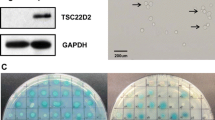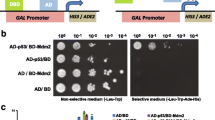Abstract
Tumor protein D52 (TPD52) is overexpressed in different cancers, but its molecular functions are poorly defined. A large, low-stringency yeast two-hybrid screen using full-length TPD52 bait identified known partners (TPD52, TPD52L1, TPD52L2, MAL2) and four other preys that reproducibly bound TPD52 and TPD52L1 baits (PLP2, RAB5C, GOLGA5, YIF1A). PLP2 and RAB5 interactions with TPD52 were confirmed in pull down assays, with interaction domain mapping experiments indicating that both proteins interact with a novel binding region of TPD52. This study provides insights into TPD52 functions, and ways to maximise the efficiency of low-stringency yeast two-hybrid screens.




Similar content being viewed by others
References
Shehata M, Weidenhofer J, Thamotharampillai K, Hardy JR, Byrne JA (2008) Tumor protein D52 overexpression and gene amplification in cancers from a mosaic of microarrays. Crit Rev Oncog 14:33–55
Boutros R, Fanayan S, Shehata M, Byrne JA (2004) The tumor protein D52 family: many pieces, many puzzles. Biochem Biophys Res Commun 325:1115–1121
Byrne JA, Nourse CR, Basset P, Gunning P (1998) Identification of homo- and heteromeric interactions between members of the breast carcinoma-associated D52 protein family using the yeast two-hybrid system. Oncogene 16:873–881
Wilson SHD, Bailey AM, Nourse CR, Mattei MG, Byrne JA (2001) Identification of MAL2, a novel member of the MAL proteolipid family, through interactions with TPD52-like proteins in the yeast two-hybrid system. Genomics 76:81–88
Proux-Gillardeaux V, Galli T, Callebaut I, Mikhailik A, Calothy G, Marx M (2003) D53 is a novel endosomal SNARE-binding protein that enhances interaction of syntaxin 1 with the synaptobrevin 2 complex in vitro. Biochem J 370:213–221
Thomas DD, Kaspar KM, Taft WB, Weng N, Rodenkirch LA, Groblewski GE (2002) Identification of annexin VI as a Ca2+-sensitive CRHSP-28-binding protein in pancreatic acinar cells. J Biol Chem 277:35496–35502
Rual JF, Venkatesan K, Hao T, Hirozane-Kishikawa T, Dricot A, Li N, Berriz GF, Gibbons FD, Dreze M, Ayivi-Guedehoussou N, Klitgord N, Simon C, Boxem M, Milstein S, Rosenberg J, Goldberg DS, Zhang LV, Wong SL, Franklin G, Li S, Albala JS, Lim J, Fraughton C, Llamosas E, Cevik S, Bex C, Lamesch P, Sikorski RS, Vandenhaute J, Zoghbi HY, Smolyar A, Bosak S, Sequerra R, Doucette-Stamm L, Cusick ME, Hill DE, Roth FP, Vidal M (2005) Towards a proteome-scale map of the human protein–protein interaction network. Nature 437:1173–1178
Fanayan S, Shehata M, Agterof AP, McGuckin MA, Alonso MA, Byrne JA (2009) Mucin 1 (MUC1) is a novel partner for MAL2 in breast carcinoma cells. BMC Cell Biol 10:7
Madrid R, Aranda JF, Rodríguez-Fraticelli AE, Ventimiglia L, Andrés-Delgado L, Shehata M, Fanayan S, Shahheydari H, Gómez S, Jiménez A, Martín-Belmonte F, Byrne JA, Alonso MA (2010) The formin INF2 regulates basolateral-to-apical transcytosis and lumen formation in association with Cdc42 and MAL2. Dev Cell 18:814–827
Sathasivam P, Bailey AM, Crossley M, Byrne JA (2001) The role of the coiled-coil motif in interactions mediated by TPD52. Biochem Biophys Res Comm 288:56–61
Chen PI, Kong C, Su X, Stahl PD (2009) Rab5 isoforms differentially regulate the trafficking and degradation of epidermal growth factor receptors. J Biol Chem 284:30328–30338
Brymora A, Valova VA, Larsen MR, Roufogalis BD, Robinson PJ (2001) The brain exocyst complex interacts with RalA in a GTP-dependent manner: identification of a novel mammalian Sec3 gene and a second Sec15 gene. J Biol Chem 276:29792–29797
Boutros R, Bailey AM, Wilson SH, Byrne JA (2003) Alternative splicing as a mechanism for regulating 14-3-3 binding: interactions between hD53 (TPD52L1) and 14-3-3 proteins. J Mol Biol 332:675–687
Sánchez-Pulido L, Martín-Belmonte F, Valencia A, Alonso MA (2002) MARVEL: a conserved domain involved in membrane apposition events. Trends Biochem Sci 27:599–601
Yaffe Y, Shepshelovitch J, Nevo-Yassaf I, Yeheskel A, Shmerling H, Kwiatek JM, Gaus K, Pasmanik-Chor M, Hirschberg K (2012) The MARVEL transmembrane motif of occludin mediates oligomerization and targeting to the basolateral surface in epithelia. J Cell Sci 125:3545–3556
Zhang Y, Deng Q, Barbieri JT (2007) Intracellular localization of type III-delivered Pseudomonas ExoS with endosome vesicles. J Biol Chem 282:13022–13032
Sonoda Y, Warita M, Suzuki T, Ozawa H, Fukuda Y, Funakoshi-Tago M, Kasahara T (2010) Proteolipid protein 2 is associated with melanoma metastasis. Oncol Rep 23:371–376
Iacobuzio-Donahue CA, Argani P, Hempen PM, Jones J, Kern SE (2002) The desmoplastic response to infiltrating breast carcinoma: gene expression at the site of primary invasion and implications for comparisons between tumor types. Cancer Res 62:5351–5357
Petalidis LP, Oulas A, Backlund M, Wayland MT, Liu L, Plant K, Happerfield L, Freeman TC, Poirazi P, Collins VP (2008) Improved grading and survival prediction of human astrocytic brain tumors by artificial neural network analysis of gene expression microarray data. Mol Cancer Ther 7:1013–1024
Colman H, Zhang L, Sulman EP, McDonald JM, Shooshtari NL, Rivera A, Popoff S, Nutt CL, Louis DN, Cairncross JG, Gilbert MR, Phillips HS, Mehta MP, Chakravarti A, Pelloski CE, Bhat K, Feuerstein BG, Jenkins RB, Aldape K (2010) A multigene predictor of outcome in glioblastoma. Neuro Oncol 12:49–57
Yang PS, Yin PH, Tseng LM, Yang CH, Hsu CY, Lee MY, Horng CF, Chi CW (2011) Rab5A is associated with axillary lymph node metastasis in breast cancer patients. Cancer Sci 102:2172–2178
Zhu G, Liu J, Terzyan S, Zhai P, Li G, Zhang XC (2003) High resolution crystal structures of human Rab5a and five mutants with substitutions in the catalytically important phosphate-binding loop. J Biol Chem 278:2452–2460
Thomas DD, Martin CL, Weng N, Byrne JA, Groblewski GE (2010) Tumor protein D52 expression and Ca2+-dependent phosphorylation modulates lysosomal membrane protein trafficking to the plasma membrane. Am J Physiol Cell Physiol 298:C725–C739
Acknowledgments
This work was supported by a project grant from the New South Wales Cancer Council (to JAB and BJS), a National Health and Medical Research Council of Australia postdoctoral fellowship (to YC), and Endeavour International- and International Postgraduate Research Scholarships (EIPRS and IPRS) (to HS), and by donations to the Children’s Cancer Research Unit of the Children’s Hospital at Westmead. The authors thank Dr Mona Shehata (CHW), Dr Erdahl Teber and A/Prof Jonathan Arthur (Children’s Medical Research Institute, Australia) for discussions, and Prof Philip D. Stahl (Washington University, USA) for ECFP-RAB5 expression plasmids.
Author information
Authors and Affiliations
Corresponding author
Rights and permissions
About this article
Cite this article
Shahheydari, H., Frost, S., Smith, B.J. et al. Identification of PLP2 and RAB5C as novel TPD52 binding partners through yeast two-hybrid screening. Mol Biol Rep 41, 4565–4572 (2014). https://doi.org/10.1007/s11033-014-3327-y
Received:
Accepted:
Published:
Issue Date:
DOI: https://doi.org/10.1007/s11033-014-3327-y




